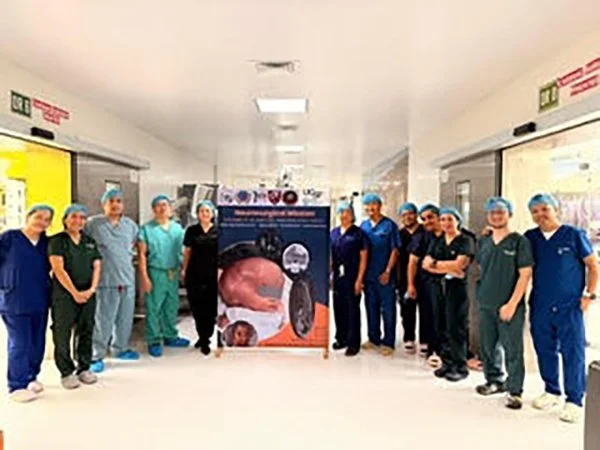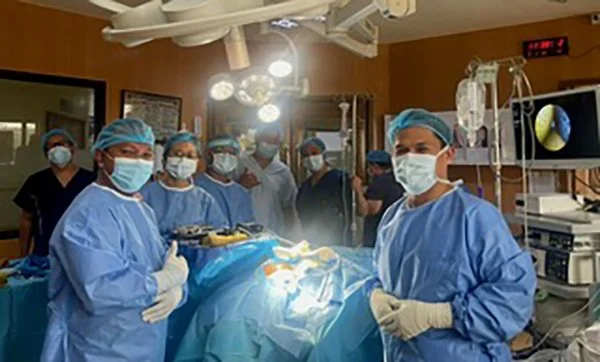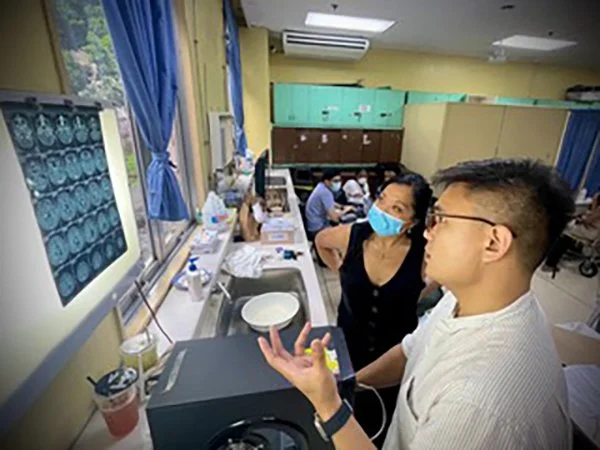A Pediatric Neurosurgeon on a Mission
/Patricia Clerkin, MD (Source: Valley Children’s Healthcare/Youtube)
“Premature babies can bleed into their brain,” explains pediatric neurosurgeon Patricia Quebada Clerkin, MD. “Blood in the brain can sometimes interfere with the circulation and absorption of the cerebrospinal fluid, and we have to sometimes help the babies manage their cerebrospinal fluid by helping clear the blood, removal of built-up spinal fluid, and or ultimately later on, shunting.”
A little later, the doctor addresses an alternative to shunting that can ensure that a baby leaves the NICU with minimal health problems. First, we get to know her by her work.
Dr. Clerkin recently completed a surgical mission at Cotabato Regional Medical Center near Central Mindanao. She volunteers and serves on the Board of Directors for Neurosurgery Outreach Foundation. Her fulltime day job is Medical Director of Pediatric Neurosurgery at Valley Children’s Healthcare in Madera, California, and she is an Associate Clinical Professor at University of California, San Francisco (UCSF) and an Associate Consultant with University of the Philippines. Dr. Clerkin, 51, is far from retiring, but she is dedicated to mentoring young Fil-Am women who are exploring a medical career.
Cotabato Regional Medical Center Sugical educational mission.
Balderdash! That might be your reaction to the inference that female doctors are rare. And if you used the term “balderdash,” you would be surprised how far surgery has progressed since Dr. Mary Edwards Walker worked as the first female U.S. Army surgeon on Civil War battlefields.
Truth be told, women with white coats and stethoscopes are a common sight in a typical urban hospital. In 2024, Association of American Medical Colleges reported that between 2004 and 2022 the active physician workforce saw a 97 percent increase in women. A whopping 371,851 American physicians (38 percent) in 2022 were women.
Let’s take a deeper dive into Dr. Clerkin’s surgical subspecialty of neurosurgery. The June 2022 edition of Frontiers in Surgery called the World Health Organization’s statistic that women represented 19 percent of neurosurgeons “a remarkable gender disparity.”
Dr. Clerkin acknowledges that she chose one of the hardest specialties in medicine. “I have been able to achieve despite the immense obstacles,” she reflects. “If I ever had any self-doubt, that has had to be erased in order to succeed in life, particularly in this challenging field.”
Gender and racial biases are prone to surface as parents advocate for their sick child. The added pressure has pushed her to always operate at the top of her game. “As a minority, underrepresented woman, I have always felt that we have had to present, achieve above and beyond the average in order for people to have confidence in us. And we do it.
“I think sometimes our need to present ourselves as confident in what we do is mistaken as arrogance, and that is unfortunate.” She admits, “I suspect you want your neurosurgeon to be confident.
“If I could be an example to other Filipino women who want to break out of the norm, because it’s the thing I’ve been in my lifetime,” says Dr. Clerkin.
Why should Fil-Am girls follow in Dr. Clerkin’s footsteps? The first chapter of her biography isn’t unusual to the man on the street among the 10 US cities Asian Pulse describes as “overflowing with Filipinos.”
The Making of a Neurosurgeon
At one year old, Dr. Clerkin emigrated with her family from Quezon City to the Filipino enclave of National City in San Diego County. She is one of four siblings. Her late father, Edwin Quebada, was from Pangasinan Province and worked as a non-uniformed civil engineer for the US Navy. Her mother is still living. Her maiden name is Patrocinio Bravo and was a homemaker from Tagum City in southern Mindanao. Dr. Clerkin is married to William Clerkin. She had her children in her early thirties. Neither of the two is becoming an MD, but she is determined to build a legacy of female Fil-Am brain surgeons.
The young Patricia Quebada with her grandfather in his backyard garden in National City, CA.
The second chapter gets interesting. Patricia Clerkin did her undergraduate work at University of California, Berkeley and completed her medical studies at New York Medical College. At Dartmouth-Hitchcock Medical Center in Lebanon, NH, she finished her residency. Additional pediatric neurosurgery training took place at the Hospital for Sick Children in Toronto, Canada and Nationwide Children’s Hospital in Columbus, Ohio.
Pioneering Pediatric Neurosurgery
Epileptic seizures are introduced to U.S. schoolchildren as early as grade school. Rather than remain passive observers, they are taught to stay alert and help if a classmate or adult collapses in uncontrollable convulsions. With understandable trepidation, children learn how to protect a person with epilepsy from harm during the thirty seconds to three minutes a seizure may last. Yet, the underlying assumption that epilepsy is untreatable—and that its symptoms must simply be accommodated—is not true in all cases.
“There are many types of surgery that can help epilepsy,” states Dr. Clerkin. “Often, we can remove the area of the brain that is triggering seizures. Sometimes we can disconnect the portion of the brain that may be triggering seizures to stop the seizure from spreading to other parts of the brain. We can sometimes implant devices that help modulate the electrical activity that can help control seizures. We can often cure seizures with these procedures. Many times, we are able to improve and decrease the amount of seizures that occur.” She is alluding to a medical device whose implantation falls within the scope of neurosurgeons.
In 2007, Dr. Clerkin belonged to the early adopters to implant responsive neurostimulators for children with epilepsy. “I’ve always been involved in projects to help certain technologies,” she says. “Now the responsive neurostimulator is used as part of the treatment options for seizure control for children with epilepsy.”
At the Davao Regional Medical Center treating hydrocephalus with endoscopy.
Born that Way
About one in every thousand babies is born with congenital hydrocephalus, a condition marked by excessive fluid permeating the brain. The condition is often treated with a shunt that draws out the liquid, but it’s not always the ideal approach. “The problem with shunts,” she says, “is they need repair, get infected, and clog up. Shunts need repair an average of every two years. That means brain surgery each time.”
Endoscopic ventriculostomy can be an alternative to shunting under specific circumstances.
“Ventriculostomy is an internal procedure that allows us to put a diversion within the brain that reduces the production of cerebral spinal fluid.” In sum, “We can create a bypass in the brain for proper drainage of fluid instead of implanting the shunt.”
She received training on implanting the device in Uganda in 2014. “About 50 percent of hydrocephalus cases are now treated with this procedure and are doing well.
“I pride myself on keeping up with the newest technologies,” she says–and that’s an understatement.
At the University of the Philippines' Philippine General Hospital discussing scan and patient care with residents.
Breakthroughs in Imaging
Dr. Clerkin ensures that her young patients can take advantage of the breakthroughs in imaging. A new procedure made possible by cutting-edge imaging comes from the field of intraoperative confocal microscopy.
In the past a separate biopsy was a painstaking demand that extended treatment of a brain tumor. “So normally, when we take out a brain tumor, we take some tissue once we removed it, and then we send it to the pathologist. And they process the tissue,” recalls Dr. Clerkin.
“One of the things I like to do is actually take a really small piece of tissue.” She elaborates, “With intraoperative confocal microscopy the pathologist is in the operating room and uses a microscope that can really look at tissue and cells at a very cellular level.”
She comments on the significance of this procedure. “Intraoperative confocal microscopy is a technique that uses very high-powered microscope in the operating room that can allow us to see the microscopic cellular architecture of tissue. This can help us identify the tissue, for example abnormal tumor versus normal brain tissue.
“The pathologist can make a diagnosis while we’re in the operating room. We know on the spot the kind of brain tumor we are dealing with. The imaging helps us make a decision on whether to excise the tumor fully. Or if it’s malignant, the patient can benefit from super aggressive treatments such as chemotherapies.”
In addition to her ongoing work in the Philippines, Neurosurgery Outreach Foundation has sent her to Mongolia, Tanzania, Armenia, and most recently, she has become active in Ethiopia.
Videoconferencing has allowed her to assist neurosurgery teams at the University of Philippines in Manila and on Cebu. “They have well-appointed facilities,” she says. “But I’ve also gone down to other places where we are starting from the ground in a lesser resourced facility. In places lacking proper facilities, a lot of my work involves teaching very basic neurosurgery for emergency procedures.”
Modernizing Surgical Facilities
As a Neurosurgery Outreach Foundation Board Director, Dr. Clerkin is active in efforts to modernize surgical facilities on the outskirts of developing countries, so local children have access to the latest medical innovations.
She is often called upon to attempt procedures that are routine in the West but haven’t yet been implemented in the Philippines. “Our group of physicians had performed one of the first dorsal rhizotomies in the country,” she recalls. “The look on the mom’s face when her child was treated was unforgettable. She said it was a ‘miracle’ We were able to do a surgery that essentially made her daughter less stiff, less in pain with movement, easier to receive daily care, and mom was so happy.”
Dr. Clerkin crafted her pitch to appeal to readers who can help sustain her organization’s work around the world:
About one in every thousand babies is born with congenital hydrocephalus, a condition marked by excessive fluid permeating the brain.
“The Neurosurgical Outreach Foundation is a group of individuals who work together to help improve access to neurosurgical care to those with limited access in low, middle-income countries. We do this through service, training, and education with local talented regional partners, and donations of necessary resources to help achieve the treatments. We rely on donations of time from physicians and other healthcare providers, and equipment. If anyone is interested in supporting our cause they can go to https://neurosurgeryoutreach.org or they can email me directly and I can help at pqclerkin@neurosurgeryoutreach.org.”
No Era for Inaction
Pediatric neurosurgery requires practitioners to cope with desperate expectations within anxious families. “While I do have one of the most stressful jobs imaginable, I do not think it compares with the stress that some of my patients’ parents are feeling when they are encountering a problem in their child that they are completely unfamiliar with, trying to seek help, and then having to trust us to do therapies or surgeries on their child.”
She insists, “I must have faith that I have been given the skills to try and help and that we do it in the best possible way. That heartfelt smile and thank you from people is often enough to give me solace.”
Dr. Clerkin is dedicated to enabling young Filipinas to experience the same moments of personal satisfaction that she never takes for granted.
Ironically, leaving the world a better place is usually on the bucket list of generous souls who have already made a lasting difference beyond their homes and immediate orbits. A spirit of self-sacrifice and compassion enables Dr. Clerkin to help meet urgent needs around the world. She is a living saint for young women who will eradicate life-threatening diseases sometime in the future and for people outside of medicine who are willing to work toward improving conditions in underserved communities. Contact Dr. Clerkin at patricia.clerkin@hitchcock.org for inspiration.
Anthony Maddela is a staff correspondent who is based in Los Angeles. He and his family are avid birders and enjoy being a part of the Santa Monica Bay Audubon Society.
More articles from Anthony Maddela








